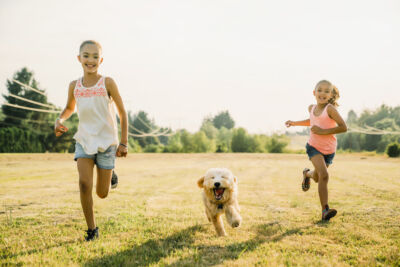 Labradoodles and Goldendoodles can make perfect companions for a lively, loving family — even if family members suffer from allergies. The Labradoodle is a gorgeous cross between a Labrador Retriever and a Poodle, and the Goldendoodle is an adorable mix between a Golden Retriever and a Poodle. Characteristics and traits can vary significantly because these pups are a hybrid breed, but they are usually incredibly people-focused, laid back, and playful, making Goldendoodle and Labradoodle training an enjoyable moment.
Labradoodles and Goldendoodles can make perfect companions for a lively, loving family — even if family members suffer from allergies. The Labradoodle is a gorgeous cross between a Labrador Retriever and a Poodle, and the Goldendoodle is an adorable mix between a Golden Retriever and a Poodle. Characteristics and traits can vary significantly because these pups are a hybrid breed, but they are usually incredibly people-focused, laid back, and playful, making Goldendoodle and Labradoodle training an enjoyable moment.
Doodles make awesome pets, especially if their owners fully comprehend the importance of training from a young age. The type of adult dog breed you end up with depends a little bit on their personality and a lot on how you take care of them. Before you begin Goldendoodle and Labradoodle training, it helps to decide exactly what kind of dog you want to have. Whether you’re after a running buddy, a children’s companion, or a therapy dog, it’s all in the dog training.
Do Plenty of Research
It is vital that you have an understanding of canine learning theory because dogs learn very differently from people. A puppy does whatever it can to get what it desires the most at that moment. There are plenty of online resources that can teach you about methods to get the best out of your training. It may be helpful to consult a puppy training professional or spend some time at doggy school to get a headstart and pick up tips from experts. Your pup is a blank slate — with your guidance, they can develop the traits and learn the behaviors that you value the most.
Be Prepared
There are several ways you’ll need to prepare your home and your schedule for your new pooch. Labradoodle and Goldendoodle puppies are curious and they love exploring their new home as they make it their own. As such, you’ll have to make sure that anything potentially dangerous is completely out of the way. The backyard will need to be entirely sealed off so they can’t run away and get themselves into mischief!
It’s also crucial that you have enough time to train your little one. Getting it right during the early stages sets a precedent for the rest of their life. Making sure that you’re there for your puppy when they need you the most will ensure that you reap the maximum rewards from your Goldendoodle and Labradoodle training. Dogs, especially young puppies, get anxious if they’re left alone. Spending as much time as you can with them helps build the foundation for a happy, confident and well-behaved dog.
Form a Bond and Gain Trust With Your Doodle
Before you do anything, you will need to develop a strong bond with your new pal to make sure they trust you. Once your doodle trusts you, you’re better equipped to keep them calm because they see you as an authority figure and listen to you. Try to keep your own energy as calm as possible — they bounce off you. While it may be tempting to get excited by their cuteness and mirror their enthusiasm, this makes it more difficult for them to listen to you and regulate their own behavior.
Start Obedience Training Your Puppy Immediately
Goldendoodle or Labradoodle training isn’t something you should put off while they settle in. Teach your furry friend what to expect from the moment they get into the home to stop them from getting confused. Managing their expectations makes it much less likely they’ll get into trouble. While you may feel like taking it easy on them for a while, you’re being kinder by setting boundaries from the beginning with basic commands.
Use Positive Reinforcement
Intimidation or fear tactics are never the best way to build a loving and secure bond between you and your fur baby. While positive reinforcement may take more patience, it’s ultimately more rewarding and pleasant for you and your doodle. To make the most of this method, reward your pooch for good behavior and ignore bad behavior. Treats, verbal praise, and clicker training reward them for a job well done. This also helps them to make positive associations with you and training time.
Basic Goldendoodle / Labradoodle Training Tips

Before you start teaching your puppy to do fun things like handshakes and high fives, make sure they understand the basics. This will be the basis for a rewarding relationship between the two of you where you’re happy with the way they behave and they’re proud to please you. Everyone has their own list of priorities and yours will depend on factors such as whether you have children or other pets. Here’s a guide to the most important Goldendoodle and Labradoodle training activities to practice with your pooch from the day he or she comes home.
Potty Training
This can seem like a daunting task, but there’s no need to fear. Potty training is a straightforward, formulaic process that your new puppy will adapt to. A consistent routine is the key to getting them toilet trained as efficiently and effectively as possible. Let them outside at the same time each day, and take them to the same spot. Ideally, do this when they first wake up, before they go to sleep, after food or drink, and after any time you’ve been out of the home. In the early days, it may be difficult for them to make it all the way through the night, so try to make provisions for this stage.
Select a word for them to associate with potty training and repeat it over and over whenever you take them to the toilet. Every time they do their business outside, give them lots of cuddles and praise, treat them and play one of their favorite games. There will be setbacks – getting it right takes time! Don’t punish or reprimand them when they slip up, as it could make them anxious and create issues around going potty. If they mess in the wrong place, take them outside to their toileting spot and give them the chance to relieve themselves. We cannot emphasize the importance of praising them when they get it right enough!
Crate Training
Not everyone opts to crate train their puppy, but it can be useful for the earliest stages of Goldendoodle and Labradoodle training. The crate gives them a safe place they can call their own. Be sure to make the time they spend in the crate a positive experience, and never leave them in there for more hours than their age in months plus one hour. For example, a three-month-old puppy can be kept in their crate for no more than four hours.
Socialization
Dogs are social animals, and Goldendoodles and Labradoodles, in particular, are happiest when they spend time pleasing people and playing. However, building confidence takes effort and guidance from their pet parent. If you want to ensure they grow up to have a balanced personality, you need to expose them to plenty of dogs, people and different situations. Take them out and about as much as possible to help them become accustomed to a range of noises, sights and sounds.
Bring them to a local dog park to get them used to spending time around other dogs. Arrange playdates with friends who have calm, well-behaved dogs that you can be sure they’ll have healthy, constructive experiences with.
Manners
Your adorable little pup has the potential to develop a host of bad habits, but these behaviors can be nipped in the bud. It’s incredibly important that you do this when they’re young because the older they get, the harder they’ll be to change. For instance, while they’re teething, they’ll be more inclined to give you a little bite. Even though it doesn’t hurt, you’ll need to discourage the behavior so they don’t continue it as adults.
Temperament and Dealing with Small Children
There are several steps to take while getting your canine cutie used to being a member of a family with children. Both pup and child will need to have clear boundaries mapped out for them so they can build mutual trust and be kind to each other.
- Provide a retreat for your dog that’s off-limits to kids.
- Let the child practice with a toy before they pick up or cuddle the pup.
- Teach kids to speak more quietly when they’re near the dog.
- Challenge the child to ignore the puppy — they’re more likely to approach the child.
- Ensure the child sits down when they play with the dog; this helps to prevent the pup from getting overexcited.
- Let the child give the doodle a special treat that it doesn’t get from anyone else so the dog has a positive association.
- Teach the child to do small tasks to help care for the dog, such as filling the bowl or helping with grooming.
Routine
It’s vital that you get your pup into a consistent routine. Knowing what to expect according to the time of day helps them to settle and feel reassured. Always wake them up at the same time, feed and walk them around the same time and do training exercises at a set time.
Patience Is Everything!
The best piece of advice for Goldendoodle and Labradoodle training is to have patience. Don’t set yourself up for disappointment — understand that there will be setbacks, and teaching the pup will take some time. Spend lots of time bonding and playing with your pooch so you can make training something fun that you both enjoy.
Essential Products for Goldendoodle and Labradoodle Training
- Treats
- Dog bowls
- Dog treats
- Dog crate
- Outdoor kennel
- Dog grooming products
- Collar
- Leads
- Dog bed
- Chew Toys
- Dog health products
- Poop bags
Goldendoodle and Labradoodle training can be a great experience for you and your puppy, as you build a bond to last a lifetime. Follow the links if you’d like to buy a Goldendoodle, or buy a Labradoodle and begin the training process. The team at Pride & Prejudoodles is happy to answer any of your questions just get in touch today.
